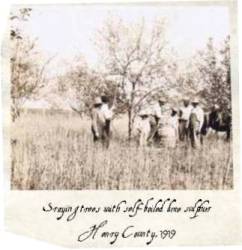The organization that today promotes healthy lifestyles for Tennesseans; helps them manage food, environmental and agricultural resources; prepares the state’s youth for a diverse and demanding future; and builds family financial skills began a hundred years ago.
The story begins with farm families struggling to survive as the Tennessee and U.S. economies began the transition from agriculture to industrialization in the early 1900s.It’s a story of committed professionals dedicating their hands to hard work and their hearts to service. Their work contributed greatly to Tennessee’s growth and progress over many generations.
1910 - December 1 - First county Extension agent employed in Tennessee. Dec. 10, Miss Virginia P. Moore was the first agent to work with women and girls in developing canning clubs. Her salary was $1,200 per year.
1914 - July 1 - The UT College of Agriculture and the USDA passed legislation to provide financial support for the organization of state divisions of Extension with the passage of the federal Smith-Lever Act.

1915 - The Tennessee General Assembly authorizes the UT College of Agriculture to organize and conduct
Agricultural Extension work.
1917 - April 6, 1917 - When the U.S. entered World War I, new Extension agents were hired to increase food production. State and county councils of defense and county food supply committees were set up. The slogan was “Food to win the war.”
The first Black 4-H Clubs in Tennessee were organized in Fayette County. When the U.S. entered World War I, the number of Black Extension agents in Fayette County increased to five women and seven men.
1922 - Wilson County held a camp for home demonstration women. This was believed to be the first such camp held in the South.
1923 - The Division of Extension becomes the Tennessee Extension Service.
1927 - First Tennessee delegation attended National 4-H Camp.

1928 - During early spring a home economics Extension agent in White County, held club meetings of the Poultry Project devoted to caponizing roosters. With the only set of caponizing instruments in the county she would caponize as many as 300. She reported that in her first meetings, there were many casualties, including several faintings of the chief surgeon.
1933 - President Roosevelt’s New Deal establishes the Tennessee Valley Authority (TVA) to oversee the economic redevelopment of the economically depressed Tennessee Valley. TVA contracts with Extension to educate rural people about the authority’s activities in the seven states affected.
1936 - Commercial electricity had been available since the late 1800s, but only 10 percent of rural homes were wired for electricity. The Rural Electrification Act made federal money available for bringing electricity to rural areas just as TVA dams began to generate ample electricity. Extension agents coordinated efforts to bring electricity to rural areas.

1939 - Tennessee cotton growers found that improved farming methods had helped them to produce an abundant cotton crop. However, market demand for the cotton fell short. With funding from the U.S. Agricultural Adjustment Administration, Tennessee Extension organized mattress-making programs across the state. Families used the surplus cotton to make thousands of mattresses that they used to replace straw and corn shuck mattresses they had been using.

1944 - U.S. Maritime Commission honored Tennessee 4-H Club members for their contribution to World War II efforts by granting them the honor of naming a ship. They chose to honor former state extension director Charles A. Keffer. Two Tennessee 4-H members assisted in christening the Liberty Ship S.S. Charles A. Keffer in Savannah, GA
1948 - The University of Tennessee is given the quitclaim deed to the prisoner-of-war camp in Crossville. The facility becomes the Clyde M. York 4-H Training Center.
1950 - In Jackson County, "some of the men in the county were not too happy about their wives being gone to home demonstration clubs, and away from home during lunch time". They decided the way to keep them home “where they belonged” was to get rid of the home Extension agent, Hazel Smithson, by not paying the county part of her salary. Word spread and at the county court meeting, a group showed up to support their agent - a number of them wives of court members. Funds for her salary remained in the budget.
1959 - Extension Home Economics diversified into new areas such as consumer education as the urban consumer became a new audience for Extension information delivered through mass media.

1960 - As the Cold War heated up the building of nuclear weapons brought the threat of widespread nuclear disaster. U.S. government agencies turned their attention to how to protect the populace and food supply in the event of a nuclear attack. Extension provides plans and models for shelters and guidance for protecting household members as well as livestock, feed and fiber from nuclear fallout.
1964 - With the passage of the Civil Rights Act, black and white agents were moved into one county Extension office.
1969 - As a part of President Johnson’s “War on Poverty,” Expanded Food Nutrition Education Program is started. Extension professionals hire, train and supervise program assistants, who work individually or in small groups to teach nutrition, food preparation and food safety, as well as the importance of physical activity and health. The Tennessee pilot counties were Coffee, Davidson, Dekalb, Gibson, Hawkins, Putnam, Roane, Robertson, Shelby, and Warren.
1971 - UT and Tennessee State University begin cooperative Extension programming.

1973 The Master Gardener Program, developed by a Washington State University Extension agent is started in counties in Tennessee. The program offers intensive training and certification to amateur gardeners, who then commit 40 hours of volunteer time to local horticultural projects.

1982 - Home Demonstration Clubs are renamed Extension Homemaker Clubs.
1990 - Tennessee Extension moved into the electronic age with all 95 county offices equipped with computers and many educational programs began to be delivered via video conference or other electronic media.

Extension promotes the Master Gardener Program statewide.
2004 - In July, the UT Agricultural Extension Service changed its name to UT Extension to reflect its broader mission.
2008 - Because of instability among oil-producing countries and environmental and sustainability concerns, the country needs energy alternatives to oil. The Tennessee Biofuels Initiative proposes to jump-start a new bioenergy industry in the state by building and operating a pilot scale cellulosic ethanol biorefinery. The principal product of the refinery will be an ethanol fuel. Extension is tasked with helping farmers begin production of switchgrass, the optimum plant material for refining.
2010 - One hundred years of UT Extension, transforming Tennessee through outreach and education services to all the state's citizens.
